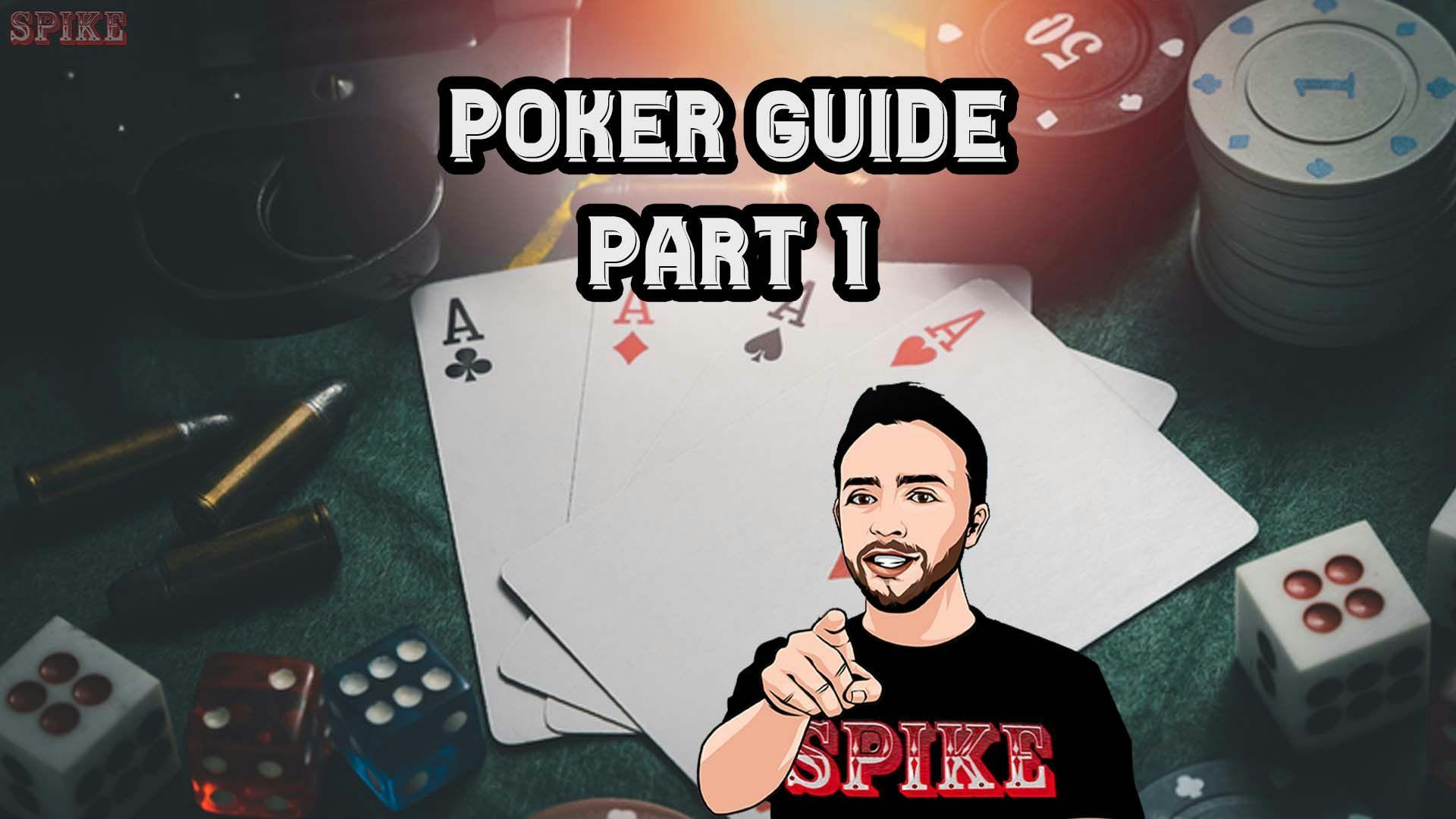Poker: How to win PART 1

DISCLAIMER:
You apply the strategies and techniques outlined in this manual COMPLETELY at your own RISK.
I cannot guarantee you will win or lose and I CANNOT be responsible for your losses.
There is a WINNER and LOSER in poker everyday, if you cannot handle losing please EXIT this manual right now.
You will incur losses, our GOAL is to MINIMIZE these losses and MAXIMIZE your profits.
NOTHING is GUARANTEED.
TABLE OF CONTENTS
Chapter
CHAPTER 1 – Introduction to Sit&Go’s
CHAPTER 2 – Observing Players and Tracking Your Play
CHAPTER 3 – Bankroll Management! An Important Rule you Must Know
CHAPTER 4 – Early Stage Strategies of a Sit&Go
CHAPTER 5 – Middle Stage Strategies of a Sit&Go
CHAPTER 6 – Late Stage Strategies of a Sit&Go’s
Chapter 1: Introduction to Sit&Go’s
Single table Sit&Go’s are the fastest growing game in online poker and there are TONS and TONS of money to be made.
My manual is going to teach you how to make a stable income everyday just by playing Sit&Go’s!
Eventually you will be able to quit your day job and work from your own home playing the game you love.
Before you can become rich playing Sit&Go’s you must truly understand the game.
A typical Sit&Go consists of 9 players with the top 3 finishers making the money.
In Sit&Go’s players buy in for a fixed amount as opposed to cash games where you can buy in for whatever amount you want and lose it in one hand on a bad beat.
I am sure whoever is reading this can relate because I sure can.
Losing a large part of my bankroll in one hand was tough to overcome, but with playing Sit&Go’s you can only lose a fixed amount which is great.
When you buy into a Sit&Go, there is also a small tournament fee, which is typically 10% of the tournament buy-in.
This means that if you enter a $10 Sit&Go, $10 is going to the tournament prize pool, and $1 is going to the poker site for hosting the Sit&Go.
This is just like the rake that goes to the house for cash games. 10% isn’t that bad and won’t kill your pockets.
When the Sit&Go begins each player is given the same amount of "play chips" that they use to play in the Sit&Go.
The chips you have aren't real money, but you have to use them to try and outlast all of your opponents.
It’s a game of survival and the top 3 finishers are awarded a cash prize.
Below is the breakdown of payment awarded for finishing in the top 3:
1st Place Win 50% of the prize pool
2nd Place Finish 30% of the prize pool
3rd Place Finish 20% of the prize pool
You must realize that single table Sit&Go’s are very rapid, because the blinds are constantly being raised.
On almost all online poker sites on average blinds are increased every ten minutes, and as the tournament progresses and an ante is added as well.
Blinds start to eat everyone’s chip stack which is why the Sit&Go finishes extremely fast.
Whether its 3 am or 3pm, Sit&Go’s can be entered in at anytime around the clock.
They are accurately running around the clock at just about every single online poker site.
You will always find a game no matter what.
This means that as soon as you lose in one of the Sit&Go’s you can join another immediately.
Many weak players don’t feel like waiting around for a cash game, so they join a Sit&Go and play horrible.
Another benefit is the chips’ sitting in front of you is not real money chips and you can ONLY lose a set amount.
At a cash table you can lose all of the money you have at any time, especially to a suck out.
It is absolutely the worst feeling in the world.
In a Sit&Go however, you can only lose what the buy in was for the tournament.
A bad beat or suck out won’t kill your bankroll.
TIP!!!!
I found that the best time to play any type of poker, whether it’s a Sit&Go, a Tourney or a cash game, is round about 03:00 in the morning, especially on a Saturday morning.
Why?? A lot of people just came back from the pubs, clubs or any other party and then wants to play some poker.
Some of them would have had quite a lot to drink and their game would be way down.
Playing poker after you had a few drinks is the worst choice you can make.
You will feel like you are invincible and will then make very stupid calls and bets.

Chapter 2: Observing Players and Tracking Your Play
Before we get into the strategies of early stages, middle stages, late stages, then taking down first place you must understand how crucial 4 key tactics are that almost always go unnoticed.
Observing players during a game is extremely important, because once you figure a player out you can take advantage of them.
For example if someone always raises and then bets the pot right after a raise, or if a player is constantly being bullied and pushed off hands take notes.
Note taking is free on every poker site and is a valuable tool that most people haven’t even used.
These notes you take will help you in later stages of the Sit&Go tournament or in future Sit&Go’s.
When you start playing Sit&Go’s hours a day, on average 5 at a time, you will start seeing many of the same players over and over especially if you stick to one site.
When you observe players, you must be aware of 3 categories.
Short stacks, Mid Stack, and the Large stack.
Let’s start off with the short stack.
Short stacks are more than likely to go all in with average hands such as an extremely low pocket pair or Ace and a low off suite card.
When you are in a hand with a short stack you should rarely bluff, because more than likely the majority of their chip stack is already in the pot and they will not be scared to dump the rest of it in.
When you are entering a pot with an average hand make sure to check where the short stacks are at on the table.
If they have already folded then you are safe to play these kinds of hands.
Though, if a short stack is in the blinds or has not acted yet on his turn, you may want to re-evaluate entering the pot.
There is a great probability that a short stack will move all in, so if you have an average hand you will be obligated to either fold, or make a call and try to get fortunate.
If you are in the small blind with a strong hand, and a short stack is in the big blind, you can play another way than normal.
If it is folded to you, just call, because the short stack 90% of the time will try to move all in here.
If you would have raised, there is a greater chance that they would fold, and you lose the extra tournament chips you could have won by just calling in that situation.
The next opponent that you need to observe around the table is the middle stack.
The middle stack is the player you should be attacking in the later stages of the Sit&Go, which we will discuss later in this Casino guide.
The reason for this is the middle stacks are trying to patiently wait out the short stacks to finish in the top 3, and make some money.
Being aggressive is vital here when you are playing against a mid stack, as they are the player most likely to fold decent hands to any kind of bet.
If you are in the small blind, and the big blind is a mid stack, you should be trying to steal their blind more than any other type of stack if all players fold around to you, you it’s best to raise just about every time, as the mid stack will be trying to play cautiously to make the money.
If your raise gets called by a mid stack in this situation you need to slow down.
When they call your raise, the majority of their chip stack is now in the pot, and now they will play the flop with the same tactics a short stack uses; going all in with garbage hands.
The final opponent you must observe is the large stack.
This type of opponent can be extremely risky to get in a showdown with and can cause you to get knocked out in a hurry if you are not careful.
Large stacks are more probable to gamble to try to knock other players out.
When you have a mediocre hand, you should avoid trying to bluff the large stack.
More than likely, he/she may call just to have a chance to knock you out.
The opposite can also be true. When you have a strong hand, you should be looking to play against a large stack.
Also another few key things to watch are the following: sometimes you will find yourself in a Sit&Go where players go all in frequently.
Many people refer to them as “all-in maniacs”.
Unless you are dealt a high pocket pair or can catch top pair on the flop with a good kicker, it is just best to sit back and watch them knock out each other.
I find it funny watching them trying to knock each other out with horrible hands! Once they knock each other out its game time for you.
At this point in the game the blinds should still be real low, so often you will find that there are 6 people left, and you only need 3 more gone to make the money.
It’s best to start out tight a gradually loosen up as the game advances.
On the opposite side of the spectrum, sometimes you will find yourself in a Sit&Go where it is boring and there is no action going on at all.
Try to entertain yourself and have patience, this is actually a very good thing.
You may not have a chance to win a large pot at the beginning stages, but in the long run you are slowly building your stack to take down first place.
If you are in this situation it is best to take charge of the table and show them who is boss.
You can bluff more without getting caught, bet people off their draws, etc.
Please note that as the Sit&Go progresses player’s games may change and start loosening up.
You must adjust accordingly.
Chapter 3: Bankroll Management- An Important Rule You Must Know
One of the biggest problems many players face when playing Sit&Go’s is that they will play tournaments to high for their bankroll.
This can cause you to lose all your money quickly and go on tilt.
A general rule of thumb is to have a bankroll of roughly 20-30 times the Sit&Go buy-in amount.
I have made a simple chart below which you can print off and use over and over again. It has helped me greatly.
Lots of poker players throw bankroll management out the door and don’t believe in it.
I got news for them, YOU NEED TO START BELIEVING, and in a HURRY!
Here is a great tip: Move up or down a level as your bankroll allows.
If you are losing, move down in buy-in level and if you continue to win move up.
Use good judgment and take action quickly.
If you wait too long you will lose, all of it! Also play at a meaningful money level to you.
This means that the buy-in amount should be at ease, as well as challenging.
Not so low that a loss is ignored.
Nor so high that you are perspiring the entire game!
| BUY IN + USUAL FEE | BANKROLL REQUIREMENT |
| $5 + $0.5 | $110 - $165 |
| $10 + $1 | $220 - $330 |
| $20 + $2 | $440 - $660 |
| $30 + $3 | $660 - $990 |
| $50 + $5 | $1100 - $1650 |
| $100 + $9 | $2180 - $3270 |
| $200 + $15 | $4300 - $6450 |

Chapter 4: Early Stage Strategies of a Sit&Go
During the early stages of a Sit&Go the rule of thumb to always follow is "tight is right".
Many of the “all-in maniacs”, as we discussed early, will be all-in early.
This will knock out 2-3 players before you may even play a hand, which will greatly increase your chances of landing a spot in the money.
When I talk about the “early stages” of a Sit&Go, I am referring to the first three blind levels.
Your goal during the first 3 blind levels is just to survive, as you will be able to outsmart players as the tournament progresses when players began to bet less.
Just because the blinds are low compared to your chip stack, you still need to avoid just limping in with marginal hands.
This will cause you to get beat by hitting top pair because your kicker will more than likely not hold up, or you will get outdrawn.
You are rarely going to hit the flop hard with these types of hands. If you avoid this, it will more than likely keep you out of trouble!
When you do get a strong hand before the flop, you need to be aggressive.
Blinds at this time will be low so a raise of 5-6x the big blind will have to be necessary.
If you were to only raise the standard 3x big blind according to what the poker strategy books will tell you in that situation, you will more than likely see multiple players call.
This will cause you a greater chance of your big hand being cracked.
If you have a large pocket pair such as AA, KK or QQ you are still more likely to get a caller if you raise it 6x the big blind.
I am sure you would rather be in a heads up situation than in a multi way pot especially if the flop comes with a flush draw or straight draw on the board.
Even if everyone folds because of your raise, it’s not a big deal, at least you won something instead of being knocked out early in the tournament because you decided to be greedy and got cracked.
In the early stages you should never want to put all your chips in the pot preflop, unless you have AA or KK.
Even a hand like QQ can be cracked easily by AQ or a smaller pair, laying it down to a multi-player all in will save you money in the long run.
I know it’s hard to fold them ladies, but sometimes you just have to do it! It’s more profitable to save your chips for later in the tournament to gamble with.
If you have a hand such as AK or AQ and you raise just about 6x the big blind, you need to carefully evaluate what you are going to do on the flop.
If one player has already come in with you and the flop is bad, let’s say 10, 8, 2, than it is more likely than not he will call a continuation bet.
When you put in your preflop raise and the flop does not help your hand you need to slow down and avoid bluffing chips away.
If check in this situation, and your opponent bets, it may be very possible he is bluffing, but you should lay it down.
There are still plenty of chips left that you can use when you have a stronger hand.
When the Sit&Go progresses in the early rounds and you just aren’t getting any cards, do not be discouraged.
You may also notice that everyone’s chip stack may be slightly higher than yours and other players are building their chip stacks while you are just folding.
Patience, patience, patience! Having a big stack early may be nice, but it is not necessary.
The crucial time of a Sit&Go is in the middle and late stages.
In the middle and late stages that’s where the skill full players shine and accumulate chips.
Never feel pressured to start to play hands just because you feel that you need to start building a stack.
During the early stages, you could fold every single hand, and still be in excellent shape on your way to taking down first in the middle and late stages.
Below is a quick recap…
Early Levels:
Play tight, flawless poker
Only bet when you have a hand
No bluffing
Don't get involved with the “all in maniacs”
Take notes and observe all the players at the table
Chapter 5: Middle Stage Strategies of a Sit&Go
When I talk about the middle stages of a Sit&Go I am referring to when the blinds have increased 4-6 times.
By now the field of players should be down to 5 or 6 players, hence the middle stage.
The middle stage of a Sit&Go is a critical time of play, as the blinds are putting pressure on many players.
In the early stages we needed to play tight, now we are shifting are gears and playing aggressive.
The reason to play aggressive is you want to build a large chip stack for the later stages to take down first place.
One way to build your stack during this time is to make smart moves and bluffs.
By watching players during the early stages and taking notes, you should have a good idea of who is weak and who can be bluffed.
For example, let’s say you have 76c in the big blind, and it is folded to the small blind.
Your observations have told you that this player is weak, and has folded on the flop to bets in the past.
The flop comes 5-9-J with one club. If that player checks you need to bet.
Since this player has been a passive player, he is going to fold 95% of the time, but even if he doesn’t fold you still have a gutshot draw as well as a backdoor flush draw.
Let’s just say this player calls your bet.
The turn brings a K (not a club), and he checks again.
By his play you can either put him on a straight draw, or a low pair.
Since he is a passive player, you should make another bet.
A pot size bet right here should cause the player to fold.
If he calls this bet again, you have to give him credit for the hand and check/fold the river unless you improve.
Unlike the early stages example when you check/folded AK when the flop came bad, let’s say you have the same hand AK.
You put in a 2x the big blind raise, and the big blind calls.
The flop is 729, and the big blind checks.
It is extremely likely he has a big unpaired hand like QJ.
Having the blinds constantly growing and you need to build your stack, you can no longer play so conservative and you must take risks.
In this situation you should make a pot size bet, and if it is called check/fold the rest of the hand unless you improve.
As discussed earlier also, it is very important to learn how to play against players with small, middle, or large chip stacks.
Hands should be consistently being played differently depending on who you are in the hand with.
You should definitely not try to bluff short stacks and large stacks, as both will likely call.
Slow playing can be used to earn you many chips if executed right.
I am going to use an AK example again.
Let’s say you have AK in the big blind, and the small blind (they are a short stack) raises you.
In this situation you can try just calling.
Reraising here might scare him off if he has still a good amount of chips left, but if you just call he is more than likely to go all in on the flop even if he does not hit a thing!
Remember, during the middle stages do not be afraid to go all in preflop with an exceptional hand.
If you hold pocket Jacks or Queens in the big blind, and an aggressive player with a middle stack chip amount raises you from the small blind, it is correct to go all in here.
If you just call and you see a horrible flop with aces or kings, you just put yourself in a hard position.
Since the other player is extremely aggressive it is likely they are trying to steal blinds and will fold to your reraise.
In the middle stages please remember this is the time to start building a chip stack.
Blinds are at a reasonable amount, so you can still outplay people without feeling the pressure that you need to make a game changing move soon!
If you can build an average stack, you will be in great shape for the late stages.
Below is the recap of the middle stages.
Mid Levels:
Tighten up even more
Steal the blinds when you can
Position is key
Watch your stack size in relation to the button
Know when the next blind level is coming
Bluffing is now an option
Don't go on tilt
Chapter 6: Late Stage Strategies of a Sit&Go
For the late stages of a Sit&Go, I am referring to 5 players or less.
By now blinds will be eating everyone’s chip stack up and putting lots of pressure on all players, but the large stacks.
The fact that it is shorthanded and the blinds are enormous makes you use a new style of play to succeed and win.
When you reach the final 4 players in the Sit&Go, you will see many unique situations.
You must face all these situations and the only way you can get better is to practice.
The first problem is that someone has to get knocked out, in order for YOU to reach the money.
This is referred to as being on the “bubble”.
There is no worse feeling that playing so well in a Sit&Go just to lose in 4th place.
If anything I would rather get knocked out in 9th, then waste my time and get knocked out in 4th.
Everyone’s game changes during this time.
In order to survive, make the money, and take down first place you must adjust your game.
What I mean about adjusting your game is you need to become more aggressive than other players.
Most players, excluding big stacks, will fold and play passive so they can make the money.
More often times than not, this will result in the player NOT making the money.
They constantly will be folding away their blinds and not increasing their chip stack by not taking down any pots.
When you are entering a pot during this stage, you need a stronger hand to call than you do to raise.
The reason is because if you are going to have to play the flop against another opponent, you need to have a very strong hand.
If you are raising, you will need a lesser hand, as there are good chances everyone will fold and you will take down the blinds.
One example here is if you hold a hand like 10 10.
You may want to limp in and try to see a good flop.
However, if you hold a hand like QJ, you should raise to try and take down the pot right away, as you would need to hit the flop to make a hand.
In many situations you can get tricky with your play at this stage because people aren’t playing their normal game.
One example of this is if you held KK in the big blind, and a mid size stack raised from early position.
If it is folded to you, you can just call.
This makes it seem like you hold either a mid pair, or big unpaired cards, as long as the flop is not horrible with no ace especially, you can check.
Your opponent will almost always bet there.
After the players preflop raise, he will have a much shorter stack and likely to try and take the pot down even if he doesn’t hit.
Once he goes all in you can make an easy call and knock him out.
Knocking a player out with an excellent move is a great feeling that you will feel over and over again by following this strategy.
If you had by chance reraised preflop in this situation, the player may have been able to get away from the hand, unless he had a similar strong hand.
By acting like you had a weak hand, you can earn yourself a larger pot while also knocking out another player if you execute it right!
Here is a recap of the late stages.
Late Levels:
Loosen up and become more aggressive
Put the spotlight on stealing the blinds
Play according to your stack size
Try to trap your opponents
Following is a chart of hands to play in early, middle, and late position along with the early, middle, and late stages of the Sit-N-Go.
Please print this out and use it when you’re playing on your own!
| PROGRESSION OF TOURNAMENT | POSITION | HANDS YOU SHOULD PLAY |
| Early | Early | AA,KK,QQ,JJ,AK |
| Early | Middle | AA,KK,QQ,JJ,AK,TT,99 |
| Early | Late | AA,KK,QQ,JJ,AK,TT, 99,88, 77, 66, 55, 44, 33, 22 |
| Middle | Early | AA,KK,QQ,JJ,AK,AQs,AQ |
| Middle | Middle | AA,KK,QQ,JJ,AK,AQs,AQ,KQs, TT, 99, 88 |
| Middle | Late | AA,KK,QQ,JJ,AK,AQs,AQ,KQs, TT, 99, 88,77, 66, 55, 44, 33, 22 |
| Late | Dealer | AA,KK,QQ,JJ,AK,AQs,AQ,KQs,KQ,JQ,JK,KT,TA,TJ,AJ,TT, 99, 88, 77, 66, 55, 44, 33, 22 |
| Late | Small Blind | AA,KK,QQ,JJ,AK,AQs,AQ,KQs,KQ,JQ,JK,KT,TA,TJ,AJ,TT, 99, 88, 77, 66, 55, 44, 33, 22 |
| Late | Big Blind | AA,KK,QQ,JJ,AK,AQs,AQ,KQs,KQ,JQ,JK,KT,TA,TJ,AJ,TT, 99, 88, 77, 66, 55, 44, 33, 22 |
This makes it the end for our Poker Guide first part. We hope to see you soon at Part Two.










